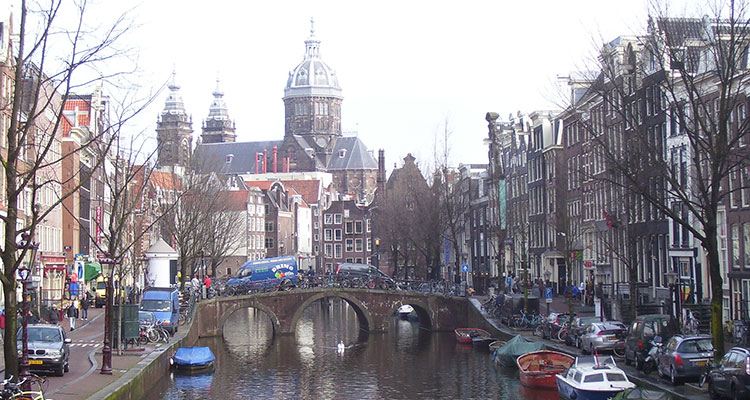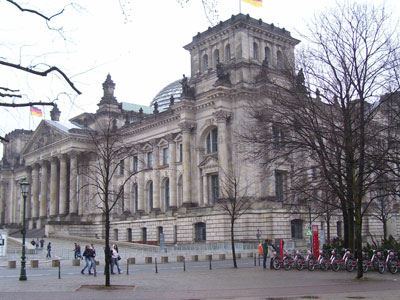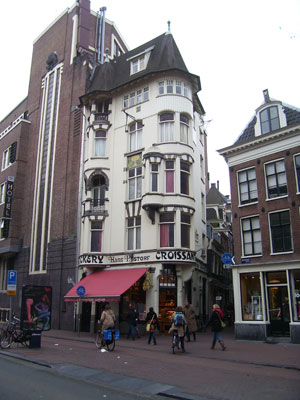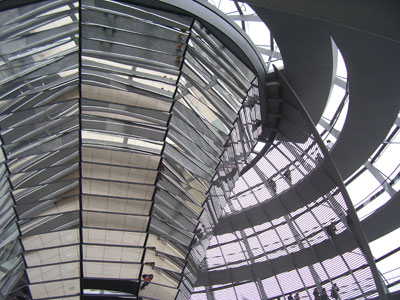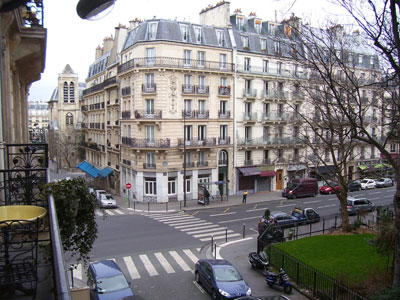Amsterdam, Berlin and Paris – an independent tour of three European capitals
This article appears on page 6 of the December 2012 issue.
by Marvin Herman; Delavan, Wi.
In our mid 70s, my wife, Judy, and I continue to travel the world independently. However, as we age, we set the bar ever lower to accommodate deficits in agility, patience and memory.
In late February 2012 we spent 18 days visiting Amsterdam and Berlin, first-time destinations for us, finishing our journey with a return trip to Paris. We chose a bed-and-breakfast in Amsterdam, a rental apartment in Berlin and a hotel in Paris.
Our economy flights — Chicago to Amsterdam and Paris to Chicago with Lufthansa — were booked on the Internet for under $800 each. The first flight was two-thirds empty, allowing us plenty of room to stretch out. The return flight, although a bit more crowded, still gave us ample room. Traveling in the off-season generally works out best for us, as we find short lines and low prices.
Arriving in Amsterdam
After landing at Amsterdam’s Schiphol Airport, we lined up at the kiosk to buy tickets for the 15-minute train ride to Centraal Station. As we feared, our magnetic-strip credit card would not work in the ticket machine. Fortunately, there was a live ticket seller nearby.
We bought four tickets for €15, two to use for this journey and two to get us back to the adjacent train station when it was time to leave Amsterdam.
Of the three cities we visited, we found Amsterdam to be the least accepting of our magnetic-strip cards.
Our B&B stay in Amsterdam, at Sunhead of 1617 (Herengracht 152), cost €99 ($129) per night for a canal-facing room. Well located on the Herengracht Canal and an easy walk from the Anne Frank House, it was a 20-minute walk from the train station.
We were warmly greeted on arrival by Carlos Cecilio, the affable owner. We felt the advantages of the view, the cleanliness of the B&B and its location in an upscale neighborhood outweighed the negatives of a lack of a common room for guests’ use (other than the breakfast room), no in-room TV or coffee maker and the tight dimensions of the room, itself.
Carlos kindly helped us up the narrow, winding stairway with our luggage.
Pushing ourselves to get through the jet lag, we had lunch at the nearby Café Kalkhoven (Prinsengracht 283), enjoying beer on draft, bowls of steamy homemade tomato soup and a meatball sandwich with peanut sauce to split (€18, or $23).
After a short nap, we walked to the Anne Frank House (€8). The site was very well explained through photos, videos and displays, and we were left with a feeling of deep sadness. It is unique among the sites of this type in that this true account of life lived under Nazi oppression is recounted in the actual house in which it took place, allowing the visitor to walk in the steps of the young autobiographer and hear the same church bells she heard, a reminder of life on the outside.
Attempting to shake the heaviness of the Anne Frank experience, we had dinner at Café Winkel (Noordermarkt 43), where I enjoyed a thick, meaty lamb curry with rice and a cold relish of pickled bean sprouts. Judy had croquettes filled with ground beef and cranberry. With Amstel beers, the bill was just over €25.
The customers there were younger locals; there were no tourists in sight. The waiter kindly translated the blackboard menu, written in Dutch.
The next morning, Carlos made pannini, scrambled eggs and smoothies for breakfast along with warm rolls and coffee. We were joined by a young Belgian couple, also guests, and Carlos fired off suggestions as to how we might spend our day.
Exploring the city
After strolling through the red-light district and past the marijuana-selling “coffee shops,” we soon came to the former house of one of the greatest Dutch Masters, Rembrandt van Rijn. Now a museum and open for touring, the house includes exhibits depicting Rembrandt’s life and art, which we found most interesting, especially a room at the top of the house where he kept props and books from which he drew inspiration.
As we headed back to our B&B, we wandered through the flower market, where rows of merchant stalls were filled with tulip bulbs ready for immediate planting, along with other plants and souvenirs. Walking along, we were struck by the rows of beautiful narrow houses along the canals. Most were equipped with exterior lifts to move large furniture items through the front windows because the narrow interior stairways could not accommodate them.
It is not possible to visit Amsterdam without noting the widespread use of the bicycle as a major means of transport. Large garages and storage buildings are situated throughout the city, especially near the train station, to accommodate residents’ bikes. As pedestrians, we learned early in our visit to be on the lookout for bikes coming from all directions.
During our stay in the city, we walked to the Rokin, a long shopping street, to find the Allard Pierson Museum, which had an Etruscan exhibit. As pre-Roman archaeology is Judy’s favorite interest, I indulged her by remaining agreeable as she enjoyed a leisurely visit.
We also visited the Jewish Historical Museum (Nieuwe Amstelstraat 1), which has many exhibits depicting life in the Jewish community before, during and after the Nazi occupation. Most interesting were the filmed interviews of people who had survived the Holocaust, recounting their experiences of returning to Amsterdam to find nothing of their culture and community left to cling to.
Departing the Sunhead, we dragged our luggage back to the train station and took the train back to the airport, where we picked up our rental car from Sixt that we had rented before we left home.
The cost for the day’s rental was just under $100 for an automatic-transmission Mini Cooper with a GPS, plus another €50 for gas, for which I had to pay cash since my magnetic-strip card didn’t work at the gas station.
We headed toward Friesland, in the northeast section of the Netherlands, where we found spending the day in the country well worth the time.
Later that afternoon we returned the car to the airport in Amsterdam and rode the shuttle to our hotel for the night, De Herbergh (€79 with tax and breakfast), located in the nearby suburb of Badhoevedorp. Our room was large and clean, the staff friendly and the water hot.
On to Berlin
In the morning, we retraced our route to the train station at Schiphol and waited for our train to Berlin ($167 each, booked online at www.raileurope.com). In about six hours we reached the Hauptbahnhof (main rail station) in Berlin.
Walking to the lower level, we found the S-Bahn (city train) to the trendy Mitte section, where we had rented an apartment (88 Auguststrasse) through Airbnb.com (headquartered in San Francisco, CA). The owner of the apartment, Stefano Casertano, had received a good recommendation on TripAdvisor.com and was very helpful with directions and the like.
We were met at the apartment by a friend of Stefano. The apartment was large and well equipped, with a TV (no English-speaking stations), a washing machine and a Claviola player piano. We paid $75 per night for the five nights we stayed.
It was nice not to need to report to breakfast or leave each day so that someone could come in and make the bed. We only needed to leave the keys on the table at the end of our stay.
Wandering the nearby commercial street, we found a small market, where we bought breakfast food, pasta, vegetables and a few other staples. Later we stopped at the end of our street for a light dinner at a restaurant called Keyser Soze (Tucholskystrasse 33; phone 030 28 59 94 89), where we feasted on meatballs, sausages, potato salad and bread (€19, including two large Berliner beers).
During our time in Berlin we enjoyed many hours in this place, and it became our neighborhood tavern where we would meet and chat with locals and travelers in its friendly atmosphere. Indeed, what we enjoyed most about Berlin — and the Mitte neighborhood around Auguststrasse — was its young, hip, easygoing character. We were correctly advised by Stefano to avoid Oranienburgerstrasse, a few streets away, which is packed with tawdry tourist bars.
Exploring the city
The next morning we headed off to visit the Reichstag, the large, modern government building in which the Bundestag, or parliament, meets. We had registered online for a time slot to visit its impressive dome and saw people without such reservations turned away, even in late February.
Our free audio tour guided us up the circular staircase and pointed out the sights to be seen through the glass walls as we ascended. At the top, we could see the floor of the Bundestag through the glass ceiling below, its members in session.
After our tour, we walked across the floor to Dachgartenrestaurant, where we paid €10 for two cups of coffee inattentively served. However, the view, on a clear day, would be priceless.
Our next day was devoted to the museums on Museum Island, including the Pergamon Museum, the world-famous Altes Museum of ancient history and the Neues Museum, where we saw the famous bust of Nefertiti. The three museums we visited were accessed for free with one-day Museum Island Passes, which we purchased at a kiosk in front of the Pergamon for €14 each. Considering that admission would have cost a total of €48, the passes saved us €10 each.
Our strongest feelings about Berlin were not gathered in the museums, however, but in the Keyser Soze, which was always so warm and welcoming. We also had these feelings walking around our neighborhood and in the shops where we bought our food.
Berliners seem to project a sense of confidence, as if to say, ‘We have risen from the ashes to become the economic and cultural engine of Europe.’ And it seemed everyone over age 50 spoke English.
On our last evening in Berlin we attended a first-rate performance of “La Bohème” at the Komische Oper Berlin (€29 each for excellent seats). The hall was about 70% full, which I attributed to the fierce competition amongst the three opera companies in Berlin.
Train to Paris
After a relaxing day at “home” and one last visit to the Keyser Soze, we walked to the Oranienburgerstrasse metro stop, transferring at Friedrichstrasse, where we caught the train to the Hauptbahnhof. There we boarded our train for an overnight trip to Paris.
Arriving at Paris Est station around 10:30 a.m., we bought a carnet of Métro tickets at a kiosk and took the No. 4 line to Saint-Michel, struggling with our luggage down many steps and up many escalators. Finally we reached our destination, Hotel Residence Henri IV (50 rue des Bernardins) in the 5th Arrondissement.
Located in the Latin Quarter near the Left Bank of the Seine, our 2-room kitchenette suite with balcony, for which we splurged, paying $225 per night, was not ready on our arrival. While Judy was served hot coffee in the lobby, I went out to buy breakfast food.
I visited Maison Kayser, where I encountered a line of people half a block long waiting to buy baguettes, croissants and sweets. It was worth the wait.
Back at the hotel, we left our luggage with the porter and Judy and I walked to the market on rue Mouffetard, visiting Fromagerie Véron to buy cheese and browsing the many shops already crowded with people.
On this, our second visit to Paris in five years, we agreed that there is no place like it. The architecture, the people and the history of the city come together to create an ongoing party to which all are invited.
City sights
We decided to tour Île de la Cité and visit la Conciergerie, where the prisoners of the French Revolution, including Marie Antoinette, Robespierre and Danton, were held, tried and sent to their deaths. At the end of our self-guided tour, we stopped for a wonderful lunch at Taverne Henri IV (13 Place du Pont Neuf).
For €36, we both had hot, open-face, cheese-covered sandwiches called tartines, served with hot green salad, a glass of wine each and a shared dessert of apple, cherry and crème baked in a feathery crepe. The service was impeccable, and the small place was packed with Parisian families and businesspeople.
We seemed to be the only tourists of any nationality in the place, though we were given a menu in English. In high season, I think there would be no chance of getting a table in this place without hours of waiting or a reservation.
After lunch, we took the Northern Latin Quarter Walk outlined in “Frommer’s Memorable Walks in Paris,” which guided us along narrow alleyways and past 17th- and 18th-century buildings near the Left Bank.
We finished the northern Latin Quarter walk the next morning with a visit to the Sorbonne, stopping in the shop to buy some gifts and strolling through the massive courtyard with its large mural and statues of Victor Hugo and Louis Pasteur.
Walking from the church of St. Germaine des Pres to the statue of Georges Danton in the Carrefour de l’Odéon, guided by the same Frommer’s book of Paris walks, we followed in the footsteps of Hemmingway, Picasso, Gertrude Stein, Alice B. Toklas, George Sand and Oscar Wilde. St-Sulpice church, with its three great Delacroix masterpieces, was also worth a visit.
The next morning started out sunny, but that was not to last. As the temperatures warmed in the afternoon, it began to rain softly.
We decided to devote the day to exploring Montmartre. We caught the Métro at Maubert-Mutualité and, with a transfer, arrived at Anvers, where we followed the walking tour in “Rick Steves’ Paris,” which took us to Sacre-Cœur Basilica, the arty Place du Tertre and the various dwellings and haunts of Renoir, Toulouse-Lautrec, van Gogh and Picasso, ending up with a walk to Moulin Rouge and “Pig Alley” (Pigalle).
Our final day in Paris was sunny and clear. We ventured out on a reconnaissance trip to see how long it would take us to get to the RER Station at Luxembourg Gardens, where we would catch the train to the airport for our flight home the next morning, spending some time in the lovely park.
We can’t really decide which one of the cities we visited was the best, but we found that the accommodations we chose all were appropriate to the neighborhoods we lived in while we toured these three amazing European cities.
(The print version of this article incorrectly identified the second photo on Page 7 as the German History Museum, which is housed in the Zeughaus on Unter den Linden.) — Editor

